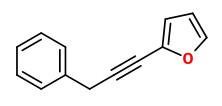Carlina acaulis L. - Asteraceae - carline thistle, silver thistle, Silberdistel, Große Eberwurz, Wetterdistel
Perennial herb, stemless or with short stem (up to 60cm high), native to Europe; flowers 4.5-7cm in diameter, inner disc florets silver-white or pale pink.
The steam distilled essential oil from root of Carlina thistle (Carlina acaulis L., Asteraceae, 3% yield) growing in Serbia is constituted nearly completely of benzyl 2-furylacetylene (carlina oxide, 97.2%).
[Composition of the essential oil from the root of Carlina acaulis L. Asteraceae., Chalchat, J.C., Djordjevic, S., Gorunovic, M., Journal of Essential Oil Research, 8(5), 1996, 577-578]
Today extracts from the roots are occasionally used in folk medicine as diuretic, diaphoretic, stomachic, and as a gargle to treat inflammations of the throat. Sometimes they can be found as ingredient of liqueurs, bitters and digestive preparations.
[Wichtl, Max. Teedrogen, Teedrogen und Phytopharmaka, Stuttgart 2002, 114-115]
 carlina oxide (benzyl 2-furylacetylene)
carlina oxide (benzyl 2-furylacetylene)
The essential oil of the roots of Carlina acanthifolia (1% yield from dried material, benzyl 2-furylacetylene 91.5%) is very similar to C.acaulis root essential oil.
[Composition of Carlina acanthifolia root essential oil., Djordjevic, S., Petrovic, S., Ristic, M., Djokovic, D., Chemistry of natural compounds, 41(4), 2005, 410-412]
„Carlina acaulis (Asteraceae) has a long history of medicinal use in Europe due to its antimicrobial properties. The strong activity of Carlina oxide, themain compound of the essential oil of C. acaulis against two MRSA strains, Streptococcus pyogenes, Pseudomonas aeruginosa, Candida albicans, and C. glabrata was confirmed. A strong and selective activity against Trypanosoma brucei brucei with an IC₅₀ of 1.0 μg/mL and a SI of 446 compared to human HeLa cells was recorded. The selective toxicity of Carlina oxide makes it a promising lead compound for the development of drugs to treat African trypanosomiasis and multiresistant gram-positive bacteria.“
[Carlina oxide - a natural polyacetylene from Carlina acaulis (Asteraceae) with potent antitrypanosomal and antimicrobial properties., Herrmann, F., Hamoud, R., Sporer, F., Tahrani, A., Wink, M., Planta medica, 77(17), 2011, 1905-1911]
see also http://www.uni-heidelberg.de/institute/fak14/ipmb/phazb/pdf-files/herrmann.pdf
Decoctions and essential oil of „Carlinae radix“ are commonly used by the locals in Serbia for the treatment of respiratory and urogenital diseases and, externally, for various skin conditions. Chemical composition of a commercial Carlinae radix herbal drug sample pointed to Carlina acanthifolia L. (Asteraceae) instead of Carlina acaulis L. (Asteraceae). The essential oil of this sample obtained by hydrodistillation „… was screened for antimicrobial activity by disc diffusion and broth microdilution methods… Both the essential oil and the decocts exhibited a very high antimicrobial activity against all tested strains, with S.aureus as the most sensitive one…“
[Commercial Carlinae radix herbal drug: Botanical identity, chemical composition and antimicrobial properties., Stojanović-Radić, Z., Čomić, L., Radulović, N., Blagojević, P., Mihajilov-Krstev, T., Rajković, J., Pharmaceutical biology, 50(8), 2012, 933-940]
„Obtained activities of Carlina herb extracts were in correlation with the presence of phenolic compounds identified in both extracts using HPLC. As previously shown, apigenin, luteolin and their glycosides are powerful antioxidants. Flavone C-glycosides (orientin, homoorientin, and vitexin) are capable of blocking chain reactions of lipid auto-oxidation, chelating metal ions of transient state, scavenging nitric compounds and blocking the synthetic reaction of nitrosamine. Orientin expresses strong radical scavenging activity and thus, high radioprotective efficacy. Some compounds identified in the investigated Carlina herb extracts demonstrated anti-inflammatory properties earlier. Apigenin has COX-2 inhibitory activity comparable to NSAIL. Vitexin and schaftoside inhibit LPS-induced mouse lung inflammation. Luteolin inhibits lipopolysaccharide-induced TNF-α production. Flavones resembling luteolin in structure (with 3',4',5,7-tetrahydroxy substitution) also resemble its anti-inflammatory activity. Isoorientin has been shown to possess significant anti-nociceptive and anti-inflammatory activities. Chlorogenic acid inhibits SE-induced T-cell proliferation and production of various pro-inflammatory compounds (e.g. IL-1β, TNF-α, IL-6, INF-γ, MCP-1, MIP-1α and MIP-1β) by human peripheral blood mononuclear cells and may serve as a potent anti-inflammatory agent. Antioxidant activity of the investigated extracts could be, at least partly, responsible for the observed anti-inflammatory effects, since it was earlier shown that antioxidants may mediate anti-inflammatory activity by direct scavenging of ROS, by influencing polymorphonuclear neutrophils oxidative metabolism and also by preventing induction of the cytokine cascade and up-regulating the expression of adhesion molecules “
[Bioactivity assays on Carlina acaulis and C. acanthifolia root and herb extracts., ĐORĐEVIĆ, S., TADIĆ, V., PETROVIĆ, S., KUKIĆ-MARKOVIĆ, J., DOBRIĆ, S., MILENKOVIĆ, M., & HADŽIFEJZOVIĆ, N., Digest Journal of Nanomaterials and Biostructures, 7(3), 2012, 213-1222] http://chalcogen.ro/1213_Djordjevic.pdf

Carlina acaulis, CC BY-SA 3.0, Author: Andreas Kraska